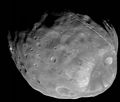Tiedosto:Phobos colour 2008.jpg
Siirry navigaatioon
Siirry hakuun

Tämän esikatselun koko: 636 × 600 kuvapistettä. Muut resoluutiot: 255 × 240 kuvapistettä | 509 × 480 kuvapistettä | 815 × 768 kuvapistettä | 1 086 × 1 024 kuvapistettä | 2 172 × 2 048 kuvapistettä | 3 500 × 3 300 kuvapistettä.
Alkuperäinen tiedosto (3 500 × 3 300 kuvapistettä, 2,72 MiB, MIME-tyyppi: image/jpeg)
Tiedoston historia
Päiväystä napsauttamalla näet, millainen tiedosto oli kyseisellä hetkellä.
| Päiväys | Pienoiskuva | Koko | Käyttäjä | Kommentti | |
|---|---|---|---|---|---|
| nykyinen | 2. huhtikuuta 2018 kello 06.10 |  | 3 500 × 3 300 (2,72 MiB) | Kaldari | more margin on right side |
| 13. marraskuuta 2008 kello 07.47 |  | 3 374 × 3 300 (2,7 MiB) | Fir0002 | == Summary == {{Information |Description=Colour image of Phobos, imaged by the Mars Reconnaisance Orbiter in 2008 |Source=NASA |Date=9 April 2008 |Location=http://www.nasa.gov/mission_pages/MRO/multimedia/pia10368.html |Author=NASA/J |
Tiedoston käyttö
Seuraava sivu käyttää tätä tiedostoa:
Tiedoston järjestelmänlaajuinen käyttö
Seuraavat muut wikit käyttävät tätä tiedostoa:
- Käyttö kohteessa af.wikipedia.org
- Käyttö kohteessa an.wikipedia.org
- Käyttö kohteessa ar.wikipedia.org
- المريخ
- فوبوس
- قمرا المريخ
- ويكيبيديا:صور مختارة/الفضاء والكون/نظرة إلى الأعلى
- قائمة أجرام المجموعة الشمسية مرتبة حسب الحجم
- بوابة:علم الفلك/صورة مختارة
- بوابة:المريخ
- بوابة:المريخ/مقالة مختارة/أرشيف
- بوابة:المريخ/مقالة مختارة/2
- قائمة الأقمار الطبيعية
- خط زمني لاكتشاف كواكب المجموعة الشمسية وأقمارها
- ويكيبيديا:ترشيحات الصور المختارة/القمر فوبوس
- ويكيبيديا:صورة اليوم المختارة/أغسطس 2019
- قالب:صورة اليوم المختارة/2019-08-03
- بوابة:علم الفلك/صورة مختارة/73
- معسكر قاعدة المريخ
- ويكيبيديا:صورة اليوم المختارة/يناير 2022
- قالب:صورة اليوم المختارة/2022-01-04
- Käyttö kohteessa ary.wikipedia.org
- Käyttö kohteessa arz.wikipedia.org
- Käyttö kohteessa as.wikipedia.org
- Käyttö kohteessa azb.wikipedia.org
- Käyttö kohteessa az.wikipedia.org
- Käyttö kohteessa be-tarask.wikipedia.org
- Käyttö kohteessa be.wikipedia.org
- Käyttö kohteessa bg.wikipedia.org
- Käyttö kohteessa bh.wikipedia.org
- Käyttö kohteessa bn.wikipedia.org
- Käyttö kohteessa bn.wikibooks.org
- Käyttö kohteessa bs.wikipedia.org
Näytä lisää tämän tiedoston järjestelmänlaajuista käyttöä.





